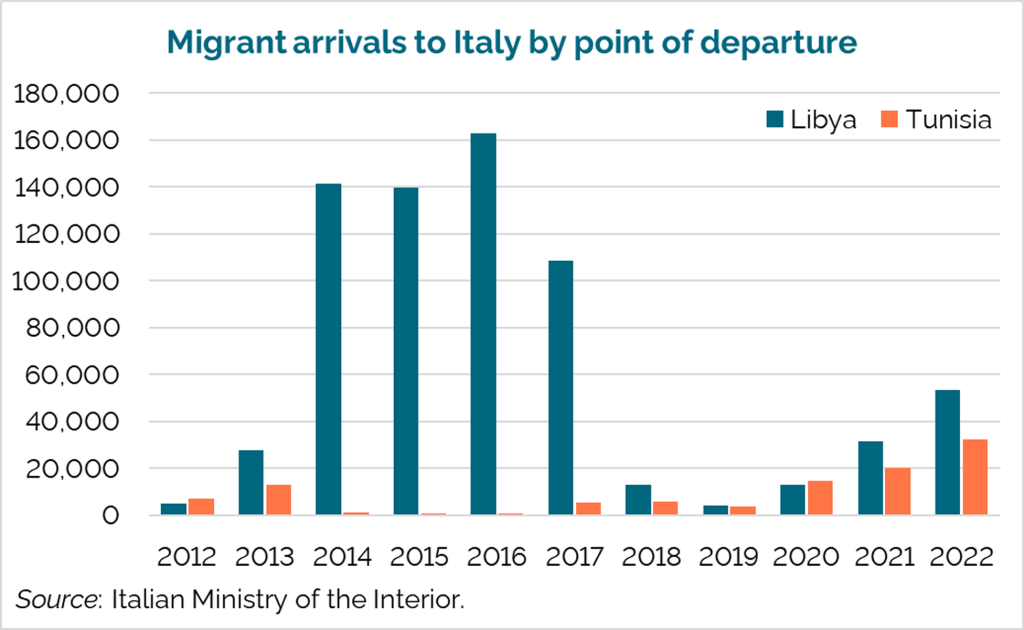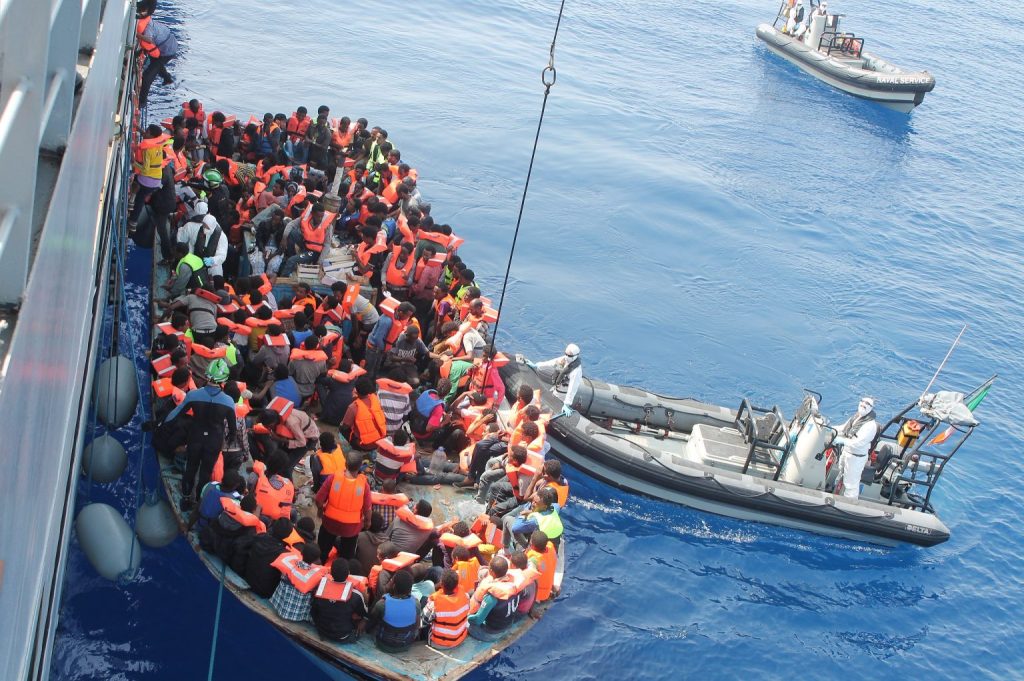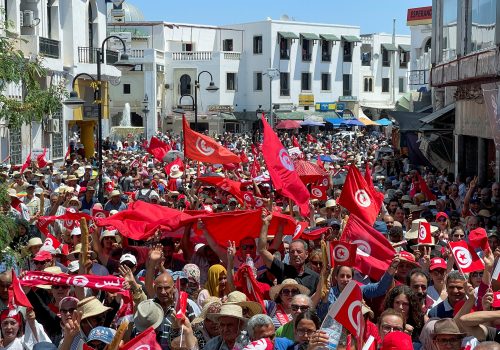Irregular migration from North Africa to Europe is on the rise again. This is particularly true along the Central Mediterranean route, which connects northern African countries (mainly Libya and Tunisia) to Italy. The latest surge in irregular arrivals that Italy is experiencing (136,000 migrants disembarked in Italy in the twelve-month period between June 2022 and May 2023) is almost comparable, in magnitude, to the period of high arrivals in 2014-2017, when on average 155,000 migrants landed each year.
But for all the similarities between the current and previous surge in migratory pressures from North Africa, much has also changed. Going through these changes can help illuminate recent evolutions in regional migratory patterns, in the causes that push African migrants to attempt perilous journeys across the Sahara Desert and the Mediterranean Sea, and in the effectiveness of policy responses from countries on both shores of the Mediterranean.
For one, today’s points of departure have become much more scattered along the North African coast. In 2014-2017, close to 90 percent of those who managed to reach Italy did so departing from Libya, and as time went on increasingly from its western shores—namely, from the sixty-mile strip that stretches in an east-west direction from Tripoli, Libya’s capital, to Zwara, a town near the border with Tunisia. However, since 2019, Tunisia and Libya have been competing for the top spot as point of departure, so much so that in the first five months of 2023, 52 percent of migrants disembarking in Italy had departed from Tunisia, while just 44 percent had done so from Libya. Even within Libya, UNHCR, the United Nations (UN) refugee agency, estimates that the majority of those who made it to Italy this year had embarked from Cyrenaica—the country’s eastern half, controlled by Field Marshal Khalifa Haftar and Tobruk’s High Council of State—rather than from Tripolitania.

The second difference, tightly linked to the first, relates to the speed of the current surge. During the previous “migrant crisis,” the surge took just a few months between 2013 and 2014. This time around, the increase in migrant departures from northern African shores has been several years in the making, slowly and steadily building up from April 2020 to today. As to the economic causes of the current increase in arrivals, it is not surprising that the surge started just a few months after the pandemic wiped out any hope for tourism receipts in 2020. This was especially important for a country such as Tunisia, which draws around 10 percent of its gross domestic product from tourism and related activities, with around 12 percent of its active population employed in the sector.
Another difference can be found in the composition of nationalities making up the current surge. In 2014-2017, close to 80 percent of all irregular migrant arrivals along the Central Mediterranean route included citizens of sub-Saharan African countries, mainly from western Africa. In contrast, between 2020 and the first half of 2022, migration patterns had “regionalized,” including a large share of Tunisians and Egyptians. It was clear, then, that irregular migration was being driven first by the “twin crises” of the pandemic, and then Russia’s invasion of Ukraine. These forces acted as an economic double whammy for African economies, first (as seen) by hitting the tourism sector, and then through the Ukraine war by making energy and food prices skyrocket. The effects rippled across the continent like waves, and people living in closer proximity to points of departure in northern African countries were the first to arrive in Europe. As time passed, people living further away from the Mediterranean shores had time to reach them. This is why, from the second half of 2022 to today, the trend has reversed, so much so that in the first five months of 2023, more than half of the migrants that reached Italy having departed from Tunisia were citizens of the Ivory Coast (28 percent) or Guinea (another 23 percent), while Tunisians made up just 13 percent of the total.
In a way it seems like, in terms of nationalities, the last year is almost “back to square one.” But there is another difference compared with the period 2014-2017, and that is the existence of active entities that police the shores where most migrant crossings occur. During the previous migration crisis, when most migrants departed from Libya and the so-called Libyan Coast Guard (LCG) had not been set up yet or had insufficient vessels, resources, or political commitment to carry out rescues/interceptions at sea, the Central Mediterranean Sea was predominantly populated by European actors and ships—be they merchant vessels, coast guard ships, or components of the civil fleet like nongovernmental organization (NGO) vessels. Since 2017, however, the Italian and European Union (EU) authorities have funded, trained, and empowered the LCG while assisting Libyan authorities in declaring the existence of their own Libyan search and rescue region, as well as setting up a Maritime Rescue Coordination Centre in 2018. Accordingly, the proportion of migrants that has been stopped while trying to leave Libya and brought back to shore has risen from none in 2016, to 12 percent in 2017, and to 68 percent in 2019, reaching the highest level of thirty-two thousand irregular migrants brought back to Libya in 2021 (51 percent of total departures). At the same time, the Tunisian Coast Guard has continued to carry out rescue/interceptions itself, with a steady rise from thirty-five hundred interceptions in 2017 to twenty-three thousand in 2021 (more recently, the Tunisian Coast Guard reported over twenty-four thousand interceptions in just the first five months of 2023).
This trend, together with the sudden drop in irregular migrant departures from Libya in July 2017, lasting over three years before the start of the current surge, shows that enhanced cooperation among EU countries and official and unofficial actors in northern African countries that have a stake in the migrant smuggling business can significantly stem the irregular flow of persons. Of course, this is achieved at the cost of increasing the number of persons who are returned to unsafe countries (as the UN has defined Libya since at least 2016) or end up in brutal illegal detention centers (in Libya, estimates have grown from five thousand detained in January 2019 to close to ten thousand by the end of 2021), and exposing EU countries to a higher likelihood of being blackmailed.
Moreover, enforcement of border controls can ebb and flow. The Libya case shows this perfectly, as the LCG’s activities at sea have dropped consistently over the past year and a half relative to arrivals in Italy. In 2023 so far, the share of irregular migrants that has been rescued/intercepted by the LCG has dropped to 23 percent, less than half the 2018-2021 average. In Tunisia, a sudden drop in irregular departures in May and June compared with expectations (close to 70 percent lower arrivals than an ISPI short-term model for forecasting irregular arrivals had predicted) has been associated not just with worse-than-average weather conditions, but also with an increase in police raids in Sfax and other Tunisian towns along the coast that have been known to be heavily involved in smuggling activity. The fact that this drop in departures from Tunisia was observed just days after visits by EU Commissioner for Home Affairs Ylva Johansson and Italian Minister of the Interior Matteo Piantedosi has generated renewed interest on political agreements among countries from the two shores of the Mediterranean. Since Italian Prime Minister Giorgia Meloni visited Tunis on June 6, departures have risen but have remained subdued compared with the previous trend.
Policy responses: Adequate or insufficient?
What do recent trends teach us in terms of policy responses? First, they show the precarious nature of political-technical agreements to stem the flow of irregular departures from northern African shores. The sudden drop in departures from Libya in July 2017 held for years, allowing arrivals to Italy to drop from around 155,000 to 11,000 in twenty-four months. But the implicit agreement among Italy and a number of Libyan militias did not do much to reduce the “demand” for smuggling services among migrants who were already living in Libya or travelling to northern African countries. On the contrary, the drop in supply of migrant smuggling services in Libya opened up the possibility that Tunisian smugglers who were already providing a number of limited goods or services (such as sturdier iron boats) to smugglers in Libya could move up the “smuggling value chain” and start offering the full package as well.
It also teaches us about the flexibility of each smuggling route, as well as the need to understand each route’s specificities. For instance, it was only with the pandemic and its impact on tourism that Tunisian migrants started looking for smuggling services in much larger numbers. As soon as demand for smuggling rose, and the industry found its footing in Tunisia, it was only natural that it would start to provide the same services to sub-Saharan African nationals severely hit by the economic effects of the Ukraine crisis. This is exactly what happened in 2022: From the outside, the transition from Tunisian nationals to sub-Saharan Africans appeared to be seamless. Moreover, as the smuggling industry in Tunisia seems to be less led by specific households but rather a much more competitive business, it is less plausible to expect that irregular departures could be stopped by striking just a handful of deals with the right counterparts. Namely, both an increase in police raids and/or paying smugglers to stop providing their services are likely to bring only a respite from the issue, to eventually be replaced by other actors willing to offer the very same services.
Local contexts
To adequately respond to irregular migration across the Mediterranean, it is crucial to comprehend the ongoing domestic crises that North African countries are facing. Among the five countries comprising the continent’s northern shore (Egypt, Libya, Tunisia, Algeria, and Morocco), Libya and Tunisia stand out as the most precarious and unstable. Consequently, there seems to be a clear correlation between instability and heightened migration.
Libya is still rocked by civil strife, split between the east, under Khalifa Haftar’s control, and the west, under the UN-backed interim government led by Abdul Hamid Dbeibeh. The ongoing conflict has made it impossible for economic conditions to improve. With unemployment continuously on the rise (now close to 20 percent) and economic growth low and volatile, locals and non-locals have found other means to make ends meet. Migration is a lucrative business for local militias both to Libya’s east and west, while non-locals (Libya hosts nearly seven hundred thousand international migrants) flock to the shores attempting to reach Europe in search of better economic and humanitarian conditions. The ongoing civil war is bad for locals, but particularly bad for migrants who face discrimination and a lack of employment as a result.
Meanwhile, Tunisia’s perilous economic conditions and an uptake in anti-migrant sentiment have been important migratory push factors. Democratic backsliding has also been a key concern since President Kais Saïed froze parliament, sacked the prime minister (July 2021), and removed fifty-seven judges from office (June 2022), with more and more political opponents seeking refuge elsewhere and looking at Europe as a safe haven.
Conclusions
Europe is negotiating a deal worth almost one billion euros with Tunisia to curb the current migration flow. Yet, conditioning financial aid to a cessation in migration is a risky business that presents long-term challenges as well as ethical concerns. For one, it allows for the recipient country (in this case, Tunisia) to hold significant leverage on European countries and use migration flows as a bargaining chip for further demands. Instead, Europe could condition its aid to a more holistic package of requests, including a return to the rule of law and renewed efforts toward a democratic transition.
Moreover, it is essential for European countries, particularly coastal states, to abandon the counterproductive approach of consistently blaming nongovernmental actors that seek to improve search and rescue efforts in the Central Mediterranean. In Italy, the current government’s practice of sending NGO ships that have carried out a rescue to faraway ports that take three to five days to reach, and another three to five days to return to the search and rescue zone off the Libyan coast, unnecessarily shortens their operational period and raises their costs. It is crucial to acknowledge that clear and repeated findings have debunked the notion that search and rescue operations serve as incentives for migrants to depart from North Africa’s shores.
Lastly, unless European countries establish safe and lawful avenues for low-skill migrants to reach their intended destinations, the problem of irregular migration will persist, or even worsen, in the coming decades. Even if new legal avenues do not directly decrease irregular crossings, they could legitimately be used to justify negotiations on increasing the return rates of irregular migrants. The current dearth of legal routes instead serves as justification for origin countries not to accept returnees, and serves to only raise political and diplomatic tensions.
Matteo Villa is Senior Research Fellow at ISPI and co-heads the ISPI Data Lab
Alissa Pavia is Associate Director at the Atlantic Council’s North Africa Program
In partnership with

Related content
Image: A vessel with migrants attempting to reach Europe from North Africa gets rescued by coast guards. | Irish Defence Forces



